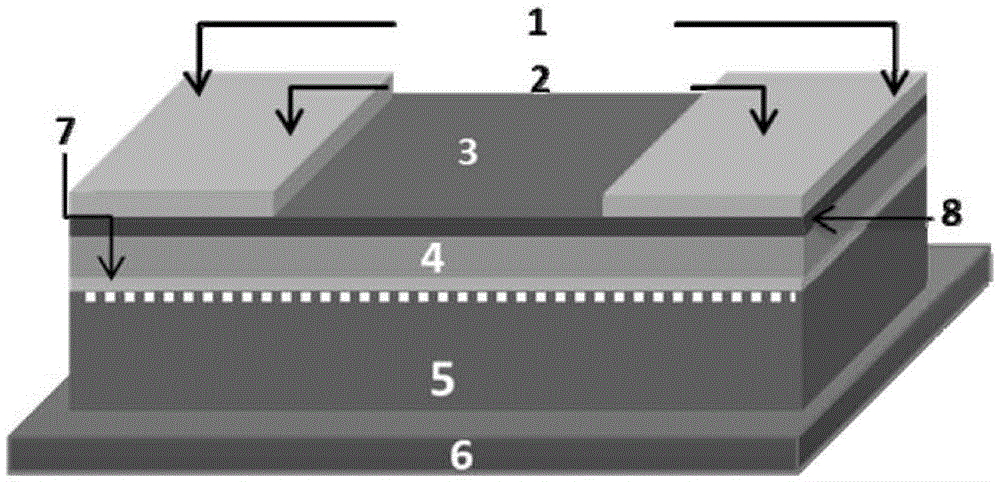A method for measuring DNA hybridization using graphene-modified high electron mobility transistors
A high electron mobility, transistor technology, applied in the field of transfer technology and DNA immobilization, can solve the problem of no detection line
- Summary
- Abstract
- Description
- Claims
- Application Information
AI Technical Summary
Problems solved by technology
Method used
Image
Examples
Embodiment 1
[0020] HEMTs with dimensions of 2 mm x 5 mm were constructed.
[0021] Use 1 mg / mL, 5 μL graphene ethanol dispersion and 23 base pair probe DNA solution (0.1 μM, 20 μL) to incubate the mixture for 30 minutes at a temperature of 18 ° C, and add the mixture dropwise to the HEMT gate Dry the polar surface at 4°C for 12 hours before performing DNA hybridization detection.
[0022] The DNA sequence used in this embodiment is as follows:
[0023] Probe DNA: 5'-AAT-CAA-CTG-GGA-GAA-TGT-AAC-TG-3'
[0024] Target DNA: 5'-CAG-TTA-CAT-TCT-CCC-AGT-TGA-TT-3'
[0025] Arbitrary DNA: 5'-ACC-TTC-CTC-CGC-AAT-ACT-CCC-3'
[0026] DNA hybridization detection is performed on the HEMT that has immobilized the probe DNA, and the "two-step mode" DNA hybridization response current can be obtained in about 5 minutes. If any DNA is dropped onto the surface of the HEMT gate, only a "one step mode" response current can be obtained. A novel current recognition mode for graphene-modified HEMTs to detect...
Embodiment 2
[0029] A HEMT of size 5mm x 5mm was constructed.
[0030] Use 0.5 mg / mL, 5 μL graphene ethanol dispersion and 27 base pair probe DNA solution (0.1 μM, 25 μL) to incubate the mixture for 40 minutes at a temperature of 20 ° C, and add the mixture dropwise to the HEMT Dry the surface of the gate at 2°C for 12 hours before performing DNA hybridization detection.
[0031] The DNA sequence used in this embodiment is as follows:
[0032] Probe DNA: 5'-AAT-CAA-CTG-GGA-GAA-TGT-AAC-TGA-CCT-3'
[0033] Target DNA: 5'-AGG-TCA-GTT-ACA-TTC-TCC-CAG-TTG-ATT-3'
[0034] Arbitrary DNA: 5'-ACC-TTC-CTC-CGC-AAT-ACT-CCC-ACT-CTG-3'
[0035] DNA hybridization detection is performed on the HEMT that has immobilized the probe DNA, and the "two-step mode" DNA hybridization response current can be obtained in about 5 minutes. If any DNA is dropped onto the surface of the HEMT gate, only a "one step mode" response current can be obtained.
Embodiment 3
[0037] HEMTs with dimensions of 2mm x 2mm were constructed.
[0038] Use 1 mg / mL, 10 μL graphene ethanol dispersion and 24 base pair probe DNA solution (0.2 μM, 30 μL) to incubate the mixture for 50 minutes at a temperature of 22 ° C, and add the mixture dropwise to the HEMT gate The pole surface was dried at 0°C for 12 hours before DNA hybridization detection.
[0039] The DNA sequence used in this embodiment is as follows:
[0040] Probe DNA: 5'-AAT-CAA-CTG-GGA-GAA-TGT-AAC-TGA-3'
[0041] Target DNA: 5'-TCA-GTT-ACA-TTC-TCC-CAG-TTG-ATT-3'
[0042] Arbitrary DNA: 5'-TTC-CTC-CGC-AAT-ACT-CCC-ACT-CTG-3'
[0043] DNA hybridization detection is performed on the HEMT that has immobilized the probe DNA, and the "two-step mode" DNA hybridization response current can be obtained in about 5 minutes. If any DNA is dropped onto the surface of the HEMT gate, only a "one step mode" response current can be obtained.
PUM
 Login to View More
Login to View More Abstract
Description
Claims
Application Information
 Login to View More
Login to View More - R&D
- Intellectual Property
- Life Sciences
- Materials
- Tech Scout
- Unparalleled Data Quality
- Higher Quality Content
- 60% Fewer Hallucinations
Browse by: Latest US Patents, China's latest patents, Technical Efficacy Thesaurus, Application Domain, Technology Topic, Popular Technical Reports.
© 2025 PatSnap. All rights reserved.Legal|Privacy policy|Modern Slavery Act Transparency Statement|Sitemap|About US| Contact US: help@patsnap.com



